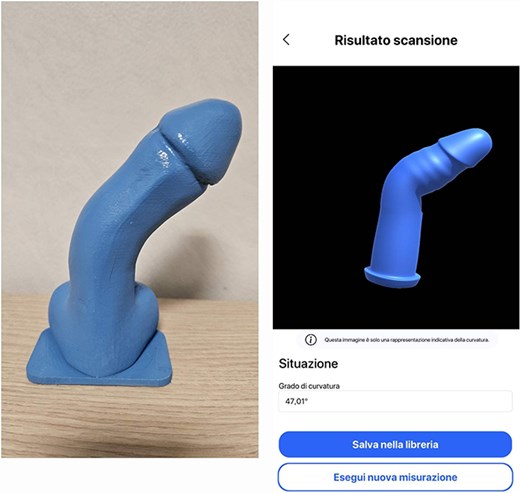-
PDF
- Split View
-
Views
-
Cite
Cite
F Crocerossa, A Abramo, M Mondaini, F Cantiello, R Damiano, N Mondaini, ASSESSING THE ACCURACY AND REPRODUCIBILITY OF A NEW SMARTPHONE-BASED AUTOMATIC METHOD FOR MEASURING PENILE CURVATURE IN PEYRONIE’S DISEASE, The Journal of Sexual Medicine, Volume 22, Issue Supplement_2, May 2025, qdaf077.052, https://doi.org/10.1093/jsxmed/qdaf077.052
Close - Share Icon Share
Abstract
Accurate measurement of penile curvature is critical for diagnosing and managing Peyronie’s disease (PD). Traditional methods of curvature assessment often face issues related to precision and consistency, potentially impacting treatment decisions and patient outcomes. To address these limitations, we developed a novel smartphone application designed to deliver precise and reliable measurements of penile curvatures.
The app’s accuracy was tested using sixteen 3D-printed penile models, each representing different curvatures, covering four predefined angles (30°, 45°, 60°, and 90°) according to the Kelâmi classification. These angles were applied to four directions: dorsal, ventral, left, and right. The app-guided measurement process involved capturing images of the model from both dorsal and lateral views using the smartphone’s front camera. The app automatically detected the penile shape and calculated both length (in centimeters) and curvature (in degrees). Each model was measured once across five different days by five separate observers (three urologists and two patients), leading to a total of 400 measurements. App accuracy was assessed visually using Bland–Altman analysis, while Root Mean Squared Error (RMSE) and Mean Absolute Error (MAE) were used to quantify precision. Intra-observer and inter-observer reliability were evaluated through Intraclass Correlation Coefficient (ICC).
Bland–Altman analysis revealed low mean bias (-3.57°) and narrow variability (95% Confidence Interval: -16.81° to 9.67°), indicating that most measurements fell within the limits of agreement. The RMSE was calculated at 7.63°, while the MAE was 5.79°, demonstrating a small and acceptable margin of error in the app’s measurement process. The ICC for both intra-observer and inter-observer reliability was 0.99, reflecting a high degree of consistency and agreement among the measurements taken by different individuals.
The smartphone application proved to be an accurate, reliable tool for objectively measuring penile curvature in PD patients. The minimal error margin, combined with its ease of use and high repeatability, makes this method suitable for both clinical and patient-guided assessments, providing a promising solution for improving disease management.
none.




